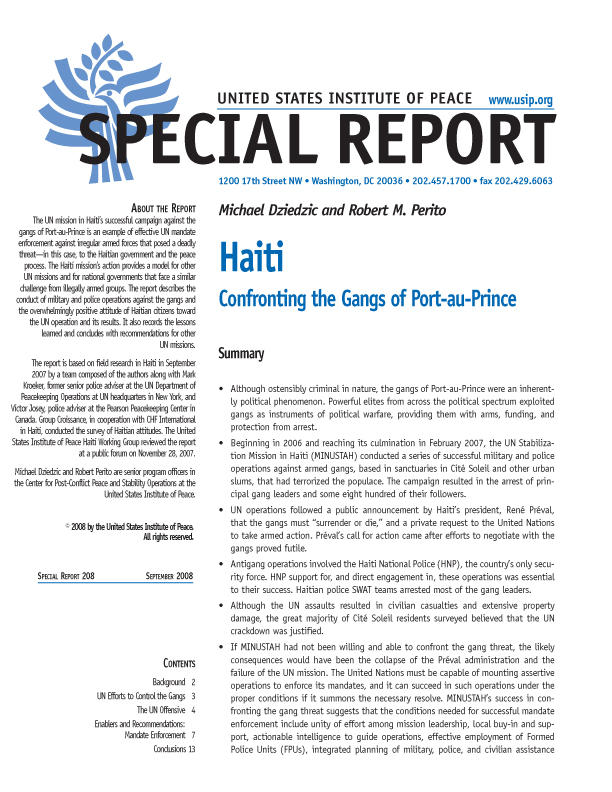The UN mission in Haiti's successful campaign against the country's gangs set a precedent for future missions. Based on field research, authors Michael Dziedzic and Robert Perito explore the conduct of military and police operations, Haitians' overwhelmingly positive views of the UN intervention and lessons learned.

Summary
- Although ostensibly criminal in nature, the gangs of Port-au-Prince were an inherently political phenomenon. Powerful elites from across the political spectrum exploited gangs as instruments of political warfare, providing them with arms, funding, and protection from arrest.
- Beginning in 2006 and reaching its culmination in February 2007, the UN Stabilization Mission in Haiti (MINUSTAH) conducted a series of successful military and police operations against armed gangs, based in sanctuaries in Cité Soleil and other urban slums, that had terrorized the populace. The campaign resulted in the arrest of principal gang leaders and some eight hundred of their followers.
- UN operations followed a public announcement by Haiti’s president, René Préval, that the gangs must “surrender or die,” and a private request to the United Nations to take armed action. Préval’s call for action came after efforts to negotiate with the gangs proved futile.
- Antigang operations involved the Haiti National Police (HNP), the country’s only security force. HNP support for, and direct engagement in, these operations was essential to their success. Haitian police SWAT teams arrested most of the gang leaders.
- Although the UN assaults resulted in civilian casualties and extensive property damage, the great majority of Cité Soleil residents surveyed believed that the UN crackdown was justified.
- If MINUSTAH had not been willing and able to confront the gang threat, the likely consequences would have been the collapse of the Préval administration and the failure of the UN mission. The United Nations must be capable of mounting assertive operations to enforce its mandates, and it can succeed in such operations under the proper conditions if it summons the necessary resolve. MINUSTAH’s success in confronting the gang threat suggests that the conditions needed for successful mandate enforcement include unity of effort among mission leadership, local buy-in and support, actionable intelligence to guide operations, effective employment of Formed Police Units (FPUs), integrated planning of military, police, and civilian assistance efforts to fill the void left by the displacement of illegal armed groups, and holistic reform of, and international support for, the legal system.
About the Report
The UN mission in Haiti’s successful campaign against the gangs of Port-au-Prince is an example of effective UN mandate enforcement against irregular armed forces that posed a deadly threat—in this case, to the Haitian government and the peace process. The Haiti mission’s action provides a model for other UN missions and for national governments that face a similar challenge from illegally armed groups. The report describes the conduct of military and police operations against the gangs and the overwhelmingly positive attitude of Haitian citizens toward the UN operation and its results. It also records the lessons learned and concludes with recommendations for other UN missions.
The report is based on field research in Haiti in September 2007 by a team composed of the authors along with Mark Kroeker, former senior police adviser at the UN Department of Peacekeeping Operations at UN headquarters in New York, and Victor Josey, police adviser at the Pearson Peacekeeping Center in Canada. Group Croissance, in cooperation with CHF International in Haiti, conducted the survey of Haitian attitudes. The United States Institute of Peace Haiti Working Group reviewed the report at a public forum on November 28, 2007.
Michael Dziedzic and Robert Perito are senior program officers in the Center for Post-Conflict Peace and Stability Operations at the United States Institute of Peace.